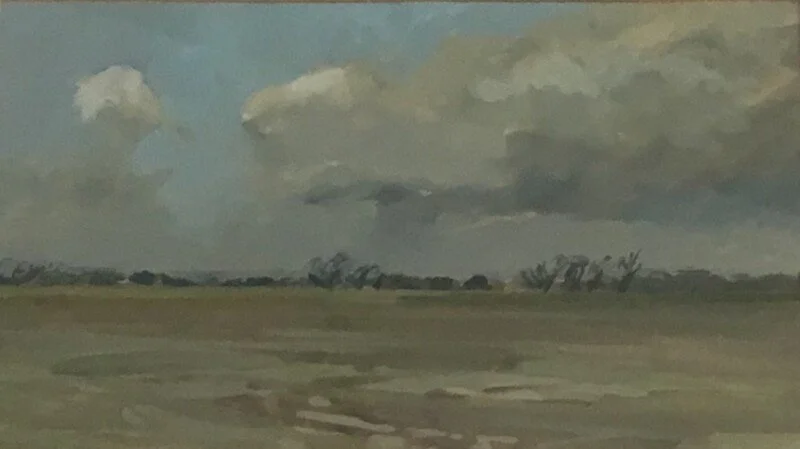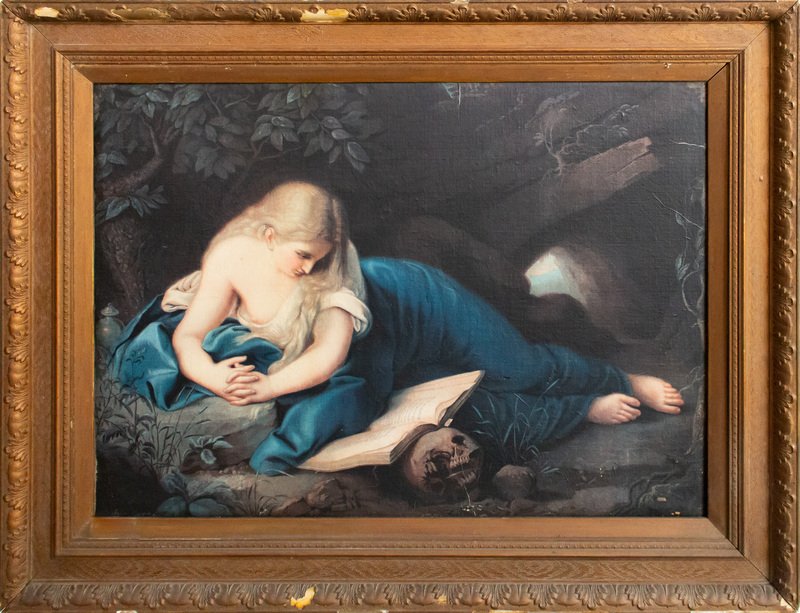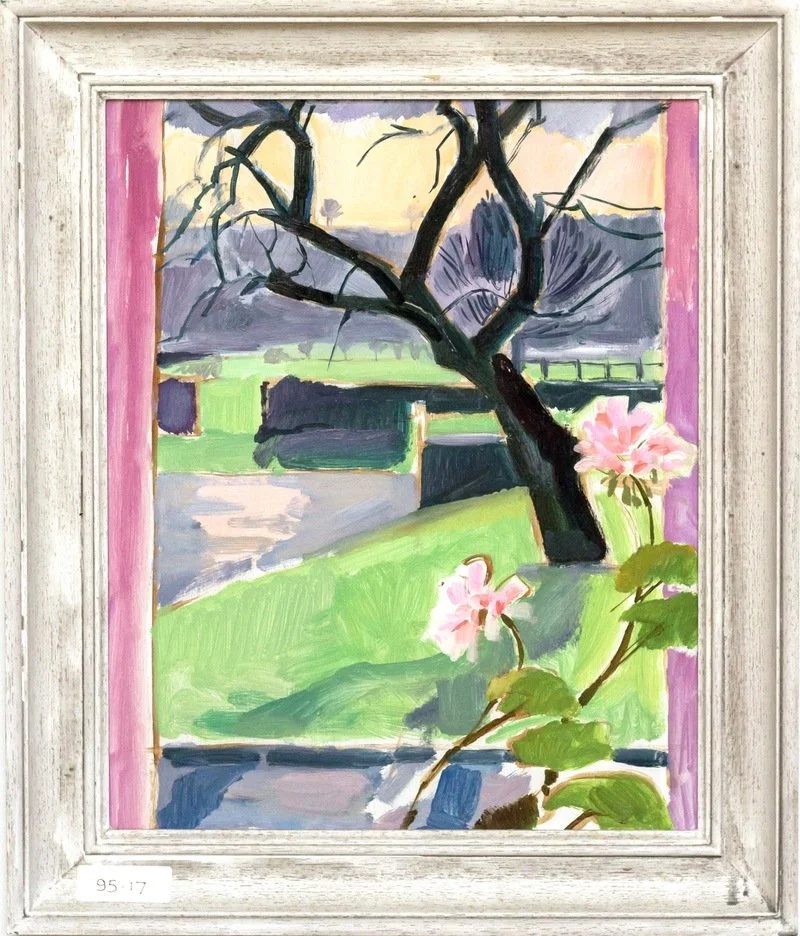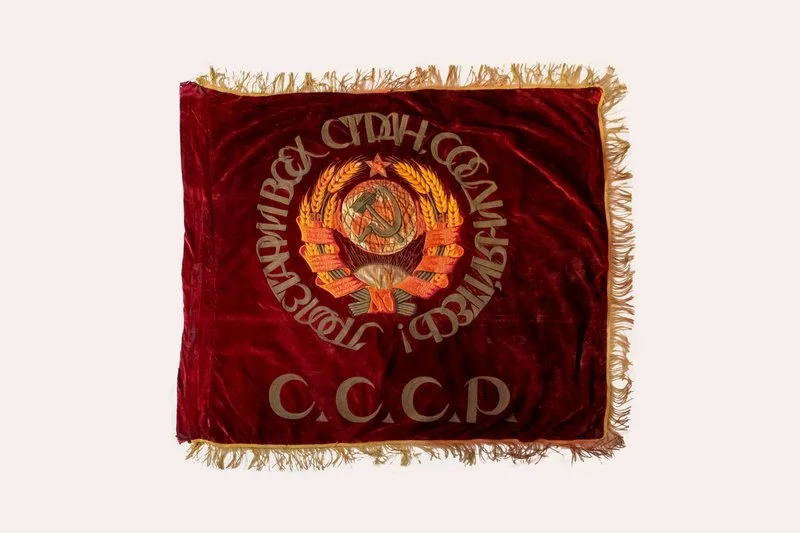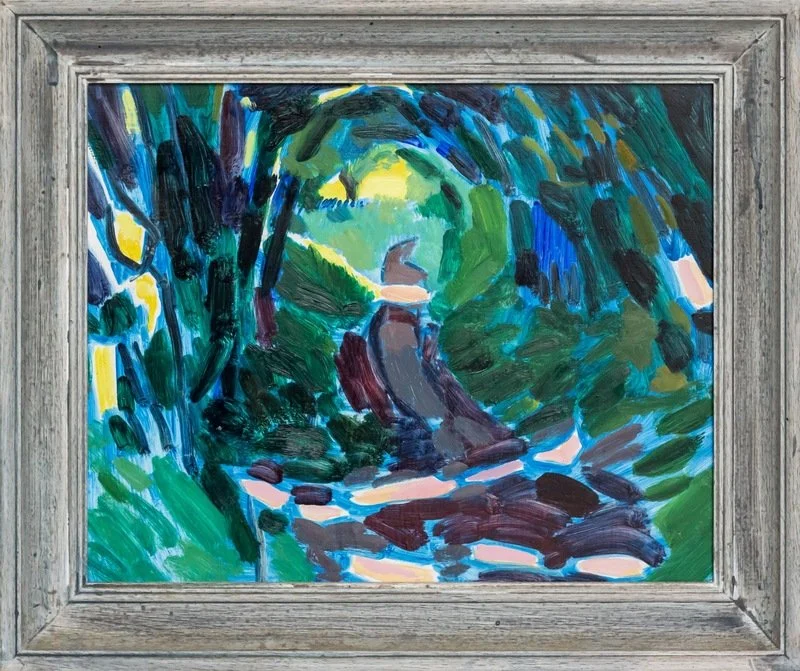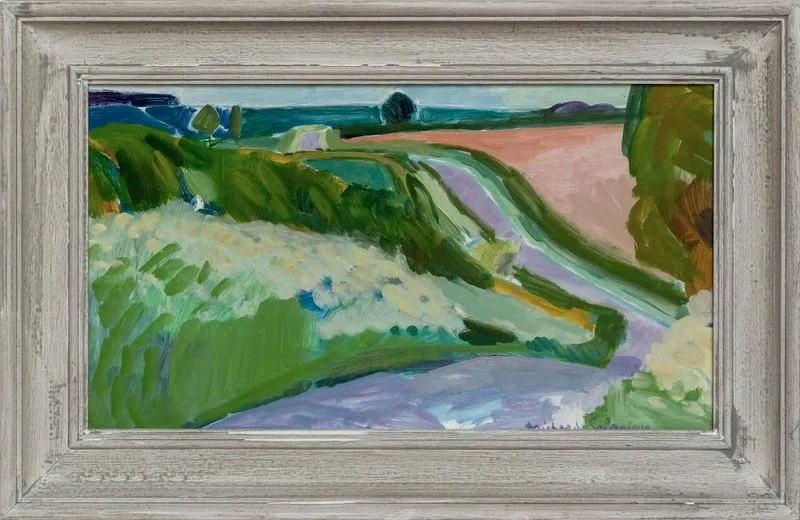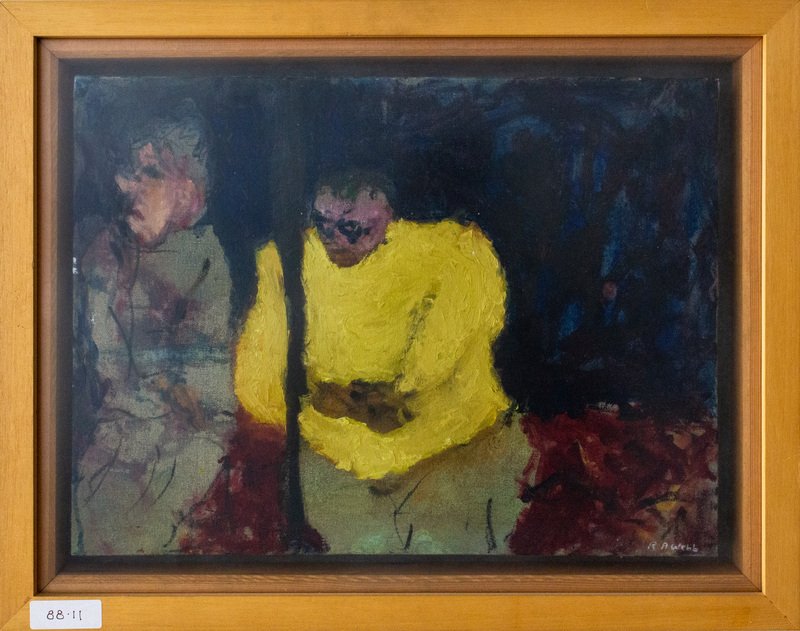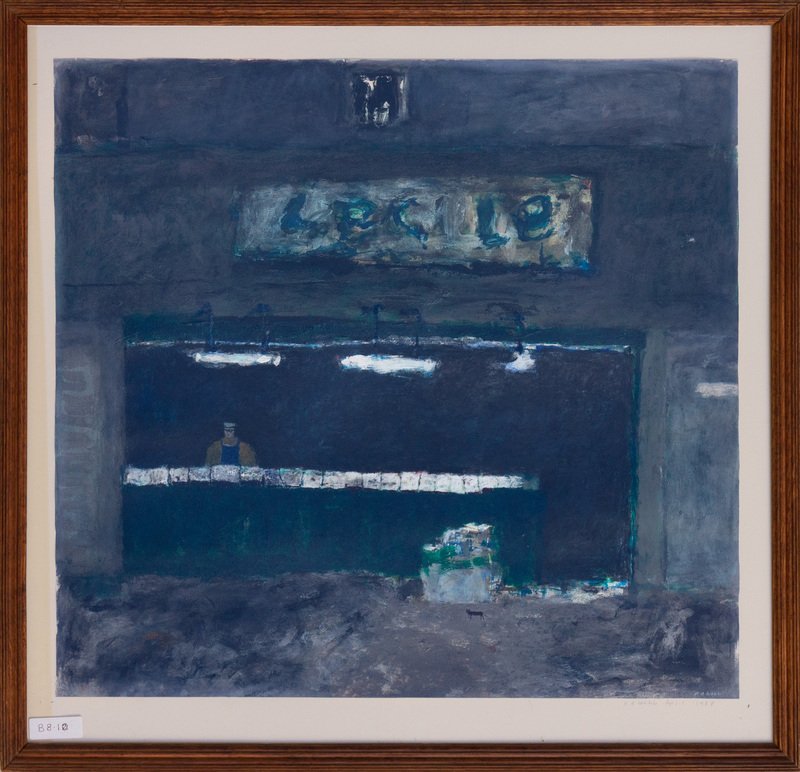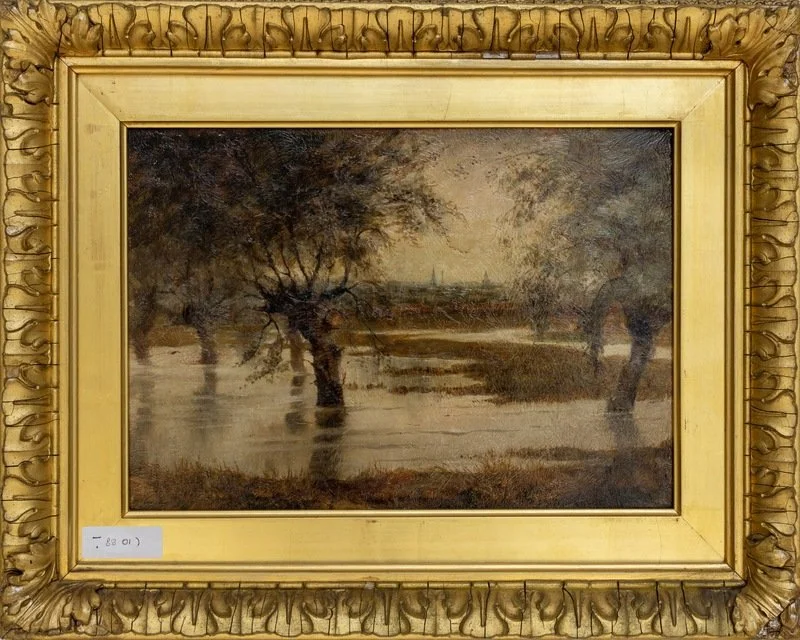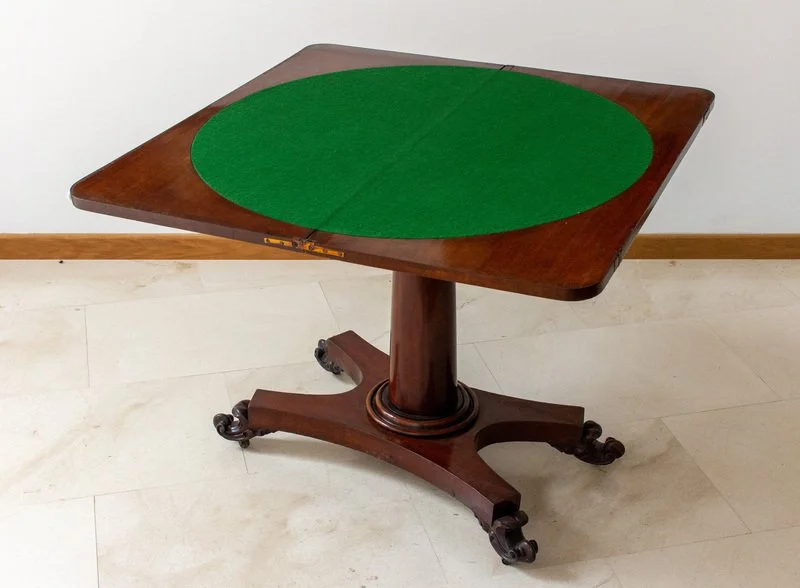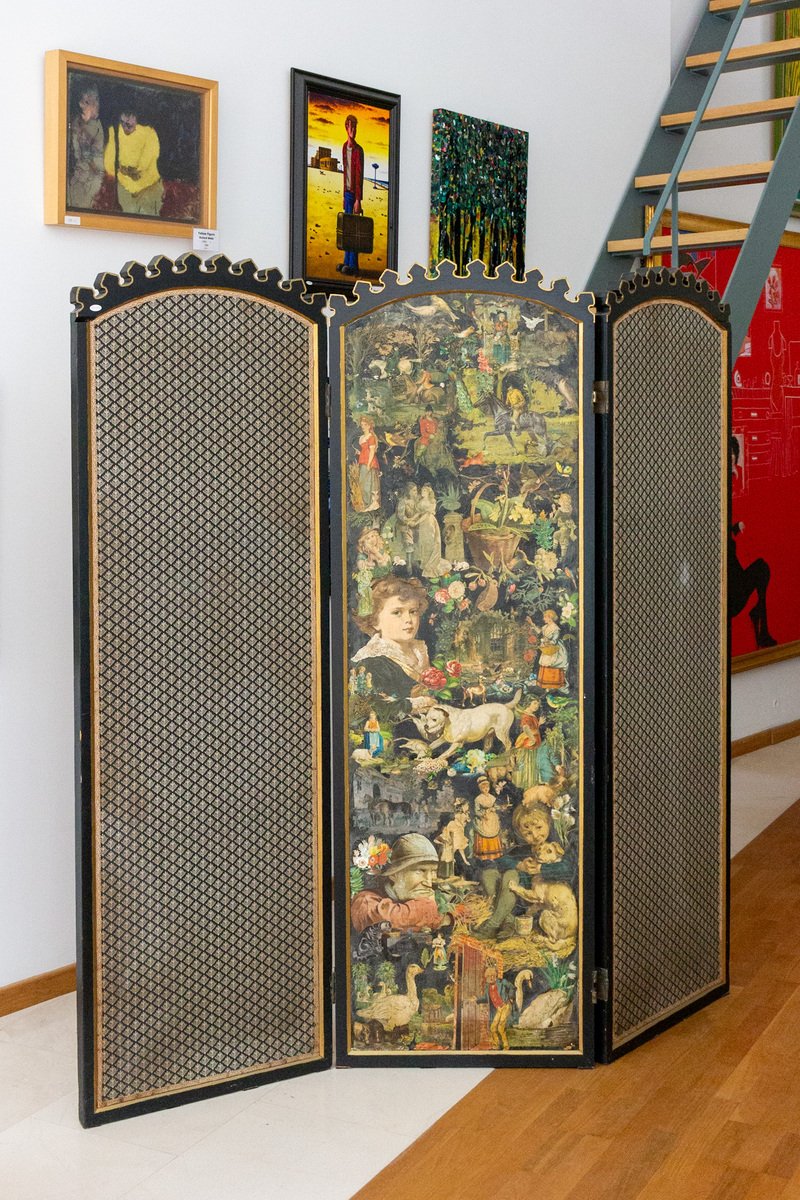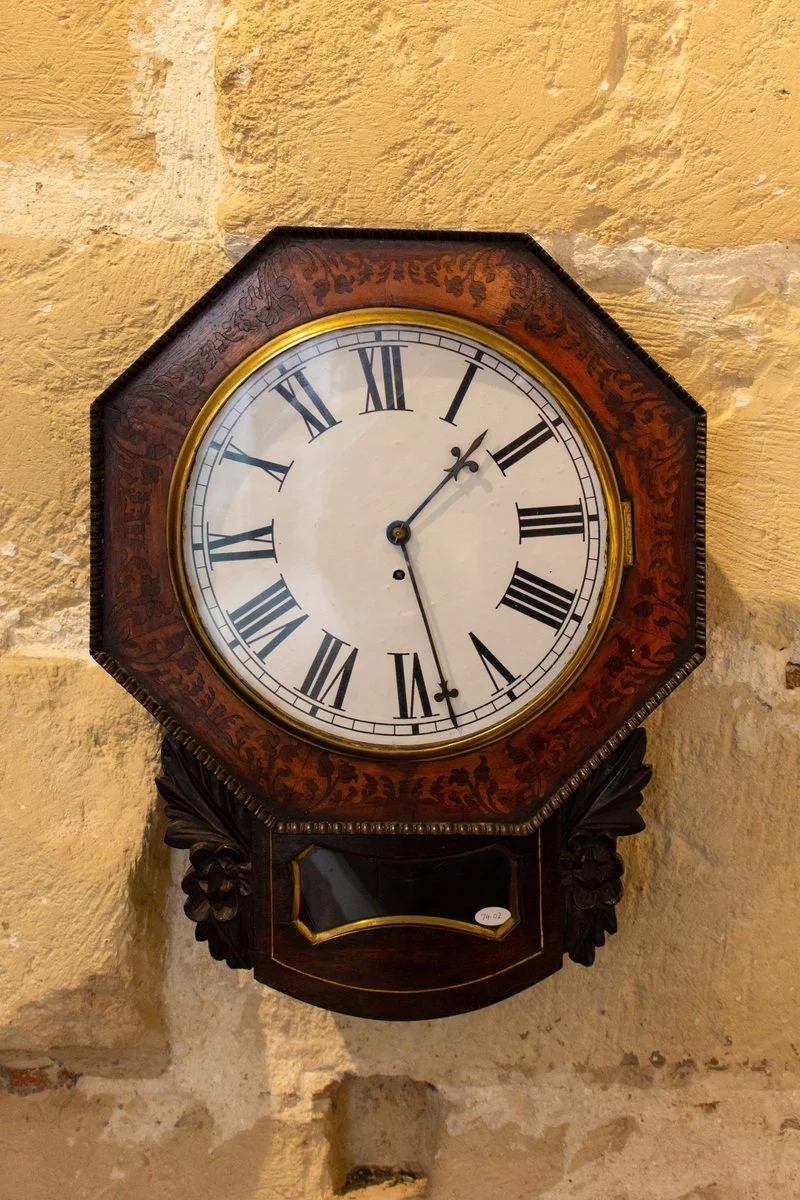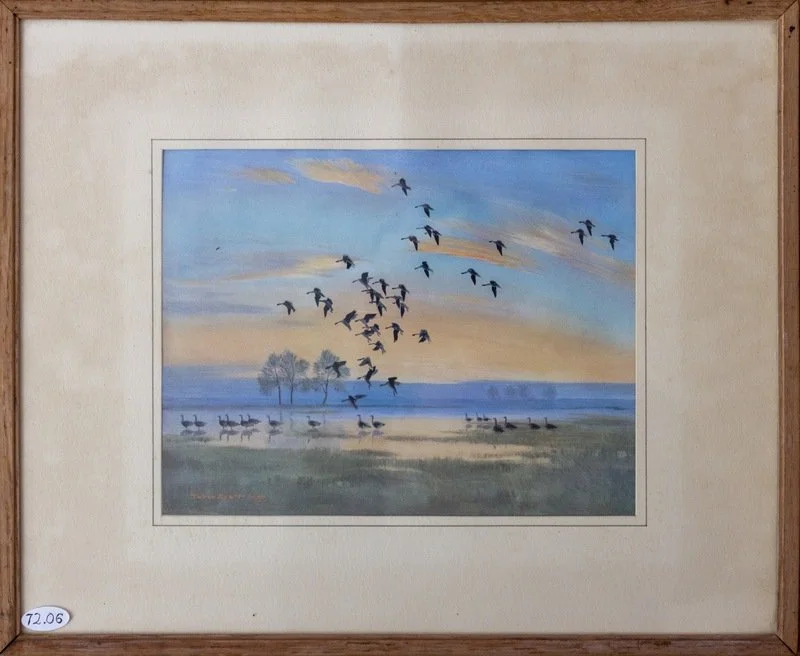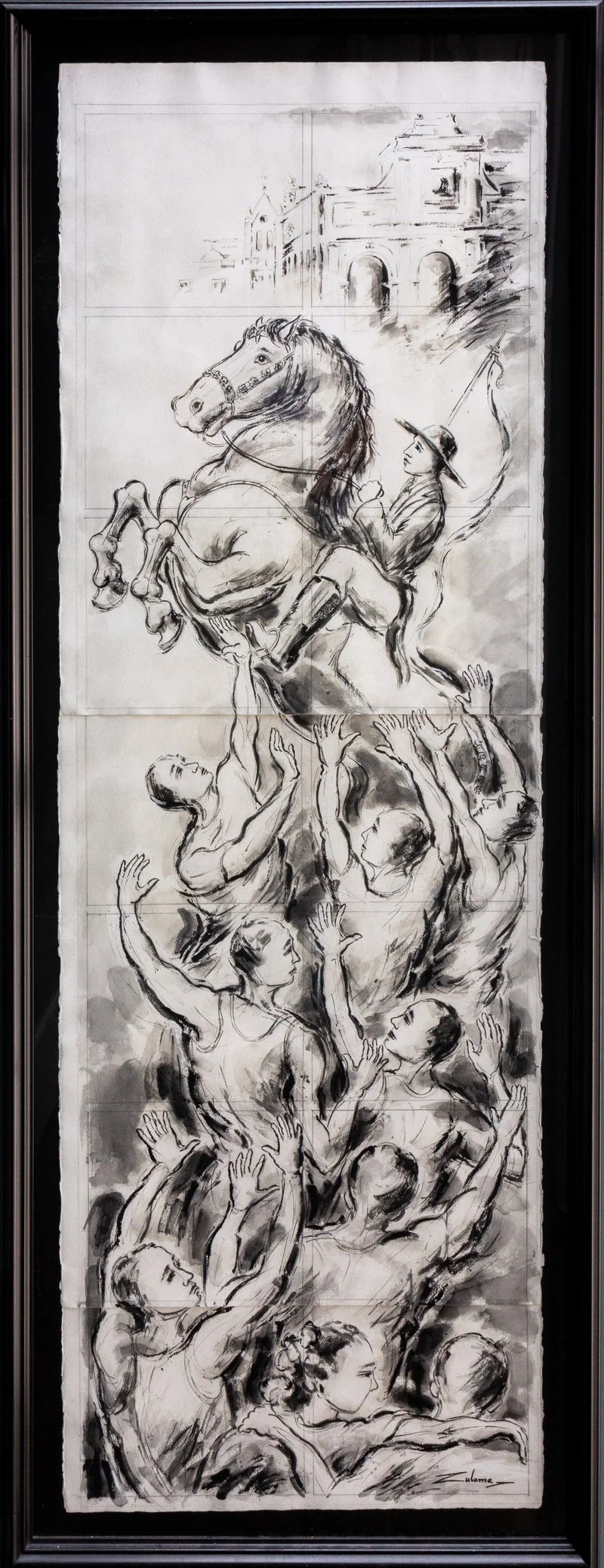98.02 Romney Marsh
English
A watercolour on paper by Yorkshire artist Brian Vale (1930 to 2008), framed. Exact date unknown. 35 cm wide by 24 cm high.
Brian Vale studied at the Royal College of Art from 1950 to 1953, and exhibited at the Royal Academy in 1959. He became the art critic for the ´Bradford Telegraph and Argus´which brought him into contact with most British artists of that period. In particular, he was a friend of John Piper (see 89.03 and 92.01) who dedicated one of his well-known paintings (Turpault Castle) to him in 1963. This brooding landscape was bought from the shop of H H Bray, at 9 Jury Street, Warwick in 1998.
Spanish
Romney Marsh
Número de catálogo 98.02
Una acuarela sobre papel del artista de Yorkshire Brian Vale (1930 a 2008), enmarcada. Fecha exacta desconocida. 35 cm de ancho por 24 cm de alto.
Brian Vale estudió en el Royal College of Art de 1950 a 1953 y expuso en la Royal Academy en 1959. Se convirtió en crítico de arte para “Bradford Telegraph and Argus”, lo que le puso en contacto con la mayoría de los artistas británicos de ese período. En particular, era amigo de John Piper (ver 89.03 y 92.01) quien le dedicó una de sus conocidas pinturas (Turpault Castle) en 1963. Este inquietante paisaje fue comprado en la tienda de H H Bray, en Jury Street nº 9. Warwick, en 1998.
97.15 Lady reading
English
A reproduction in oils on canvas by an unknown artist, dating from the late 19th century. Unsigned. Framed. 50 cm high by 90 cm wide.
This is a copy of a painting by Guiseppe Mazzoline (1806 –1876) titled ‘Woman reading a book resting on a skull’ dated 1870, which shows a reclining Mary Magdelene in the wilderness. Mazzoline’s work, in turn, is a copy of a large (121 cm high by 188 cm wide) oil painting titled ’The penitent Mary Magdelena’ by the Italian artist Pompeo Batoni (1708- 1787) painted in 1745 which hung in the Staatsliche Museum in Dresden. It was destroyed in the bombing of the City of Dresden in 1944. The penitence of Mary Magdalene is a recurring theme in Italian art from the renaissance through to the 19th century {Titian, Caravaggio, Donatello and many others), the popularity of which is attested by the numerous copies and engravings for domestic use are known to have been made. We bought this picture at the Warwick Gallery at 14, Smith Street, Warwick in June 1997.
Spanish
Señora leyendo
Número de catálogo 97.15
Reproducción al óleo sobre lienzo de autor desconocido, que data de finales del siglo XIX. No firmado. Enmarcado. 50 cm de alto por 90 cm de ancho.
Esta es una copia de una pintura de Giuseppe Mazzoline (1806-1876) titulada "Mujer leyendo un libro descansando sobre una calavera" fechada en 1870, que muestra a María Magdalena reclinada en el desierto. La obra de Mazzoline, a su vez, es una copia de un gran óleo (121 cm de alto por 188 cm de ancho) titulado 'La penitente María Magdalena' del artista italiano Pompeo Batoni (1708-1787) pintado en 1745 que colgaba en el Museo Staatsliche en Dresde. Fue destruida en el bombardeo de la ciudad de Dresde en 1944. La penitencia de María Magdalena es un tema recurrente en el arte italiano desde el Renacimiento hasta el siglo XIX (Tiziano, Caravaggio, Donatello y muchos otros), cuya popularidad se atestiguadas por las numerosas copias y grabados para uso doméstico que se conocen. Compramos esta imagen en Warwick Gallery en 14, Smith Street, Warwick en junio de 1997.
95.17 The Cottage Garden
English
Painted by Michael Sofroniou in early 1995. Acrylic on board. 39 cm. high by 31 cm. wide.
A further example of Michael Sofroniou’s landscape skills (see also 91.02 and 93.07). We bought this painting at John Davies’ ‘Spring Exhibition’ at his Church Street Gallery at Stow-in-the-Wold in Gloucestershire, in March 1995. At that time, Michael and his family were living in a cottage in a small village called Tysoe, and this evocative scene is of their garden from a bedroom window.
Spanish
El jardín de la cabaña
Número de catálogo 95.17
Pintado por Michael Sofroniou a principios de 1995. Acrílico sobre tabla. Mide 39 cm de alto por 31 cm de ancho.
Otro ejemplo de las habilidades paisajísticas de Michael Sofroniou (ver también 91.02 y 93.07). Compramos esta pintura en la "Exposición de primavera" de John Davies en su Church Street Gallery, en Stow-in-the-Wold, Gloucestershire, en marzo de 1995. En ese momento, Michael y su familia vivían en una cabaña en un pequeño pueblo llamado Tysoe, y esta escena evocadora es de su jardín desde la ventana de un dormitorio.
94.03 Brittany Cliff
English
A seascape, oil on canvas, late nineteenth century by an unknown artist, framed. 20 cm. high by 29 cm. wide.
I suppose that everyone who spends time browsing in galleries or antique shops or art fairs does so partly in the hope that one day they will stumble across an undiscovered masterpiece, or a ‘lost’ work by a famous artist. And so it was with this little painting which Jane found in Warwick Antiques, and which she managed to convince herself was a study done by one of the many impressionist painters who spent time in Brittany in the late nineteenth century. Her research led her to Eugène Boudin and his time at Etretat, but I have no evidence or documentation as to how she made this deduction. The house on the cliff ought to be identifiable I would have thought. The framing is damaged, and has extensive dead woodworm infestation.
Spanish
Acantilado britano
Número de catálogo 94.03
Un paisaje marino, óleo sobre lienzo, de finales del siglo XIX de autor desconocido, enmarcado. 20 cm de alto por 29 cm de ancho.
Supongo que todos los que pasan el tiempo explorando galerías o tiendas de antigüedades o ferias de arte lo hacen en parte con la esperanza de que algún día se topen con una obra maestra no descubierta o una obra "perdida" de un artista famoso. Y así fue con esta pequeña pintura que Jane encontró en Warwick Antiques, y que logró convencerse de que fue un estudio realizado por uno de los muchos pintores impresionistas que pasaron un tiempo en Bretaña a finales del siglo XIX. Su investigación la llevó a Eugène Boudin y su estancia en Etretat, pero no tengo pruebas ni documentación sobre cómo hizo esta deducción. La casa en el acantilado debería ser identificable, habría pensado. El enmarcado está dañado y tiene una extensa infestación de lombrices de la madera muertas.
92.02 Flag of the Soviet Union
English
Catalogue number 92.02.
Red velvet embroidered flag from the Soviet Union, circa. 1950’s. 110 cm. high by 110 cm. wide.
This flag, made from red velvet, has a red silk lining, a generous 6 cm. white string fringe on three sides, and a long narrow pocket on the fourth side for the flagpole. On the face it is machine-embroidered, largely in gold thread, with the state emblem of the Soviet Union. This consists of a five-pointed red star at the top, the hammer and sickle over the whole world, and the rising sun at the bottom, surrounded by two wreaths of ears of wheat. Around the emblem (in Cyrillic script) are the words ‘Proletarii vsex stran, sojedinjajtes’ – Workers of the world, unite. The ribbon around the wheat stalks also bears, in smaller script, the same iconic state motto in different forms of the Slavic alphabet, representing the different socialist republics which made up the Union. At the bottom are the large Cyrillic letters ‘CCCP’ – USSR.
This was bought on the Arbat in Moscow in 1992 where, at that time, anything and everything was for sale provided it was paid for in dollars. This item, like many textile objects, is not in very good condition.
Spanish
Bandera Ceremonial
Número de catálogo 92.02
Bandera bordada en terciopelo rojo de la Unión Soviética, aproximadamente de los años 50 (s. XX). Mide 110 cm de alto por 110 cm de ancho.
Esta bandera, hecha de terciopelo rojo, tiene un forro de seda roja, una franja de 6 cm de cuerda blanca en tres lados y un bolsillo largo y estrecho en el cuarto lado para el asta de la bandera. La cara principal está bordada a máquina, principalmente en hilo de oro, con el emblema estatal de la Unión Soviética. Consiste en una estrella roja de cinco puntas en la parte superior, el martillo y la hoz sobre una bola del mundo y el sol naciente en la parte inferior, rodeado por dos coronas de espigas de trigo. Alrededor del emblema (en escritura cirílica) están las palabras 'Proletarii vsex stran, sojedinjajtes' (Trabajadores del mundo, uníos). La cinta que rodea los tallos de trigo también lleva, en letras más pequeñas, el mismo lema icónico de estado en diferentes formas del alfabeto eslavo, que representa a las diferentes repúblicas socialistas que conformaron la Unión. En la parte inferior están las letras cirílicas grandes ‘CCCP’ - URSS.
Esto se compró en el Arbat de Moscú en 1992, donde, en ese momento, todo estaba en venta, siempre que se pagara en dólares. Este artículo, como muchos objetos textiles, no está en muy buenas condiciones.
91.09 Loch Lomond
English
Catalogue Number 91.09
Oils on board, by E. J. Bladon, painted in 1945. Gilt framed, 30 cm. high by 23 cm. wide.
This is a lovely, beautifully painted little oil painting, created in 1945 by artist E.J.Bladon of a scene in the Scottish highlands at Loch Lomond. It captures the slightly brooding feel of the mountains surrounding the lake, the uncertainty of the weather, the isolation, especially of the stag, and the beauty of the natural world. It continues in the tradition established in the Victorian era of Highland landscape painting when images of places including Glen Coe, Loch Lomond and the Trossachs, became parlour room panoramas that defined popular images of Scotland. This was helped by Queen Victoria's declared affection for Scotland, signified by her adoption of Balmoral as a royal retreat. The wildlife in the highlands was immortalised by English painter Edwin Landseer (1802-73) in the much copied Monarch of the Glen (1851).' In this period a Scottish "grand tour" developed with large number of English artists, including J.M.W.Turner, flocking to the Highlands to paint and draw.
We bought this, in a very dirty condition and for very little money, in a house contents sale in Edgbaston, near Birmingham in 1991.
Spanish
Lago Lomond
Número de catálogo 91.09
Óleo sobre tablero, de E. J. Bladon, pintado en 1945. Marco dorado, mide 30 cm de alto por 23 cm de ancho.
Esta es una hermosa pintura al óleo bellamente pintada, creada en 1945 por el artista E.J. Bladon, de una escena en las tierras altas de Escocia en el lago Lomond. Captura la sensación levemente melancólica de las montañas que rodean el lago, la incertidumbre del clima, el aislamiento, especialmente del ciervo, y la belleza del mundo natural. Sigue la tradición establecida en la época victoriana de la pintura de paisajes de las Tierras Altas, cuando las imágenes de lugares como Glen Coe, el lago Lomond y los Trossachs se convirtieron en panoramas de salas de estar que definían imágenes populares de Escocia. A ello contribuyó el afecto declarado de la reina Victoria por Escocia, que se tradujo en la adopción de Balmoral como retiro real. La vida silvestre en las tierras altas fue inmortalizada por el pintor inglés Edwin Landseer (1802-73), en el muy copiado Monarch of the Glen (1851). [En este período, se desarrolló una "gran gira" escocesa, con un gran número de artistas ingleses, incluido JMW Turner, que acudían a las tierras altas para pintar y dibujar.Compramos esta pintura, muy sucia y por poco dinero, en una venta para liquidar el contenido de una casa en Edgbaston, cerca de Birmingham, en 1991.
93.07 Sunken Path
English
93.07 ‘Sunken Path’, 1993, 31 cm. high by 39 cm. wide.
When I am asked, as I often am, what my favorite object in the Foundation’s collection is, I generally give as evasive or enigmatic answer as I can manage. But the body of work by a single artist that delights and affects me most is the twenty of Michael’s paintings here in Mahon, together with others owned by my daughter Ksynia and my son Richard. These two small landscapes were amongst the first pictures which we bought from him – he would have been in his early thirties then, and was living in a small village called Little Barrington on the Oxfordshire/Warwickshire border. After graduating from Oxford University in 1977 with a degree in English Language, he gained an honours degree in Fine Art at the Camberwell School of Art in 1982. He has gone on to be a prolific and successful artist who has exhibited widely – see www.michaelsofroniou.com
Spanish
93.07 "Sendero hundido", 1993, 31 cm de alto por 39 cm de ancho. Ambos pintados en acrílico sobre tablero por Michael Sofroniou (n. 1957).
Cuando me preguntan, como a menudo hacen, cuál es mi objeto favorito de la colección de la Fundación, generalmente doy una respuesta tan evasiva o enigmática como puedo. Pero el conjunto de obras de un solo artista que más me encantan y complacen son los veinte cuadros de Michael, aquí en Mahon, junto con otros de mi hija Ksynia y mi hijo Richard. Estos dos pequeños paisajes se encontraban entre las primeras obras que le compramos, ya que él tenía unos treinta años y vivía en un pequeño pueblo llamado Little Barrington, en la frontera de Oxfordshire (Warwickshire). Después de graduarse de la Universidad de Oxford en 1977 con una licenciatura en idioma inglés, obtuvo una licenciatura en Bellas Artes en la Escuela de Arte de Camberwell en 1982. Con el tiempo, se ha convertido en un artista prolífico y exitoso que ha expuesto ampliamente.
Ver www. michaelsofroniou.com
91.02 Warwickshire Countryside
English
1991, 21cm. high by 39 cm. wide.
When I am asked, as I often am, what my favorite object in the Foundation’s collection is, I generally give as evasive or enigmatic answer as I can manage. But the body of work by a single artist that delights and affects me most is the twenty of Michael’s paintings here in Mahon, together with others owned by my daughter Ksynia and my son Richard. These two small landscapes were amongst the first pictures which we bought from him – he would have been in his early thirties then, and was living in a small village called Little Barrington on the Oxfordshire/Warwickshire border. After graduating from Oxford University in 1977 with a degree in English Language, he gained an honours degree in Fine Art at the Camberwell School of Art in 1982. He has gone on to be a prolific and successful artist who has exhibited widely – see www.michaelsofroniou.com
Spanish
91.02 "Campo de Warwickshire", 1991, 21 cm de alto por 39 cm de ancho. Ambos pintados en acrílico sobre tablero por Michael Sofroniou (n. 1957).
Cuando me preguntan, como a menudo hacen, cuál es mi objeto favorito de la colección de la Fundación, generalmente doy una respuesta tan evasiva o enigmática como puedo. Pero el conjunto de obras de un solo artista que más me encantan y complacen son los veinte cuadros de Michael, aquí en Mahon, junto con otros de mi hija Ksynia y mi hijo Richard. Estos dos pequeños paisajes se encontraban entre las primeras obras que le compramos, ya que él tenía unos treinta años y vivía en un pequeño pueblo llamado Little Barrington, en la frontera de Oxfordshire (Warwickshire). Después de graduarse de la Universidad de Oxford en 1977 con una licenciatura en idioma inglés, obtuvo una licenciatura en Bellas Artes en la Escuela de Arte de Camberwell en 1982. Con el tiempo, se ha convertido en un artista prolífico y exitoso que ha expuesto ampliamente.
Ver www. michaelsofroniou.com
90.05 Moonlit Scene
English
Catalogue number 90.05
Oils on canvas, painted by Abraham Pether (1756-1812). Early nineteenth century. 55.5 cm. high by 65.5 cm. wide. Ornate gilt frame.
The English landscape painter Abraham Pether was born in Chichester in 1756. He was a childhood musical prodigy – giving a recital on the organ at Chichester Cathedral at the age of 9 – but he later chose to train as an artist in London where he worked for most of his life. He is best known for his paintings, of which this is one, which specialize in the effects of moonlight on the landscape. He had 61 of his paintings accepted for exhibition at the Royal Academy between 1784 and 1811, but like others at the time, he was in reality a polymath, experimenting with microscopes and telescopes, and with astronomy and electricity. Of his nine children, two sons were also well-known landscape painters, Sebastian Pether (1790-1844) and Henry Pether (1800-1880).
This picture, bought from Apollo Antiques, The Saltisford, Warwick, in 1990 is of an pastoral river scene – castle, ruined priory, fishermen – all with a slight feeling of mystery under the moonlight.
Spanish
Escena de luna iluminada
Óleo sobre lienzo, pintado por Abraham Pether (1756-1812) a principios del siglo XIX. Mide 55,5 cm de alto por 65,5 cm de ancho. Marco dorado adornado. Número de catálogo 90.05
Abraham Pether, pintor paisajista inglés, nació en Chichester en 1756. En su infancia, fue un prodigio musical –dio un recital de órgano en la catedral de Chichester a la edad de 9 años-, pero más tarde eligió formarse como artista en Londres, donde trabajó la mayor parte de su vida. Se le conoce mejor por sus pinturas, de las cuales esta es una muestra, que se especializan en los efectos de la luz de la luna en el paisaje. Entre 1784 y 1811, 61 de sus pinturas fueron aceptadas para ser expuestas en la Royal Academy pero, al igual que otros en ese momento, él era en realidad un erudito, y experimentaba con microscopios y telescopios, y con astronomía y electricidad. De sus nueve hijos, dos de ellos también fueron reconocidos paisajistas, Sebastian Pether (1790-1844) y Henry Pether (1800-1880).
Esta obra, comprada en 1990 en Apollo Antiques, The Saltisford, Warwick, es una escena de río -castillo, priorato en ruinas, pescadores- todo con un ligero toque de misterio a la luz de la luna.
⛔️ 88.12 Night shift
English
38 cm. wide by 54 cm. high
The first two of these three paintings were bought in late May 1988 from the artist at his degree show at the Royal College of Art in London. ‘Night Shift’ was bought in November of the same year from the Oxford Gallery, 21, High Street ,Oxford. Richard Webb was born in 1963 and attended the Camberwell School of Art and Craft from 1982 to1985 where he gained his BA degree. He then went on to study for his Master’s degree at the Royal College, which he obtained in 1988. For a while after buying these pictures, we remained in touch with him and he came to stay with us at the seaside in Essex in 1990, where, he subsequently told us, the sea and the sand gave him the inspiration for one of his later works – ‘Triple Echo’ depicting three seagulls and a little girl on an expanse of beach. He regularly exhibits in London, particularly at the Cadogan Contemporary Gallery in Chelsea.
Spanish
Las dos primeras de estas tres pinturas se compraron a fines de mayo de 1988 directamente al artista, en su exposición en el Royal College of Art de Londres. "Turno de noche" se compró en noviembre del mismo año en la Oxford Gallery, en High Street nº 21, Oxford.
Richard Webb nació en 1963 y asistió a la Escuela de Arte y Artesanía de Camberwell desde 1982 hasta 1985, donde obtuvo su licenciatura. Luego pasó a estudiar su maestría en el Royal College, que obtuvo en 1988. Después de comprar estas obras, mantuvimos contacto con él durante un tiempo, y vino a pasar una temporada con nosotros en la costa de Essex en 1990, donde, más tarde, nos dijo que el mar y la arena le inspiraron para una de sus obras posteriores, “Triple Eco”, que representa a tres gaviotas y a una niña pequeña en una extensión de playa.
Expone regularmente en Londres, particularmente en la Galería Contemporánea Cadogan, en Chelsea.
88.11 Yellow figure
English
36 cm. wide by 39 cm. high.
The first two of these three paintings were bought in late May 1988 from the artist at his degree show at the Royal College of Art in London. ‘Night Shift’ was bought in November of the same year from the Oxford Gallery, 21, High Street ,Oxford. Richard Webb was born in 1963 and attended the Camberwell School of Art and Craft from 1982 to1985 where he gained his BA degree. He then went on to study for his Master’s degree at the Royal College, which he obtained in 1988. For a while after buying these pictures, we remained in touch with him and he came to stay with us at the seaside in Essex in 1990, where, he subsequently told us, the sea and the sand gave him the inspiration for one of his later works – ‘Triple Echo’ depicting three seagulls and a little girl on an expanse of beach. He regularly exhibits in London, particularly at the Cadogan Contemporary Gallery in Chelsea.
Spanish
Las dos primeras de estas tres pinturas se compraron a fines de mayo de 1988 directamente al artista, en su exposición en el Royal College of Art de Londres. "Turno de noche" se compró en noviembre del mismo año en la Oxford Gallery, en High Street nº 21, Oxford.
Richard Webb nació en 1963 y asistió a la Escuela de Arte y Artesanía de Camberwell desde 1982 hasta 1985, donde obtuvo su licenciatura. Luego pasó a estudiar su maestría en el Royal College, que obtuvo en 1988. Después de comprar estas obras, mantuvimos contacto con él durante un tiempo, y vino a pasar una temporada con nosotros en la costa de Essex en 1990, donde, más tarde, nos dijo que el mar y la arena le inspiraron para una de sus obras posteriores, “Triple Eco”, que representa a tres gaviotas y a una niña pequeña en una extensión de playa.
Expone regularmente en Londres, particularmente en la Galería Contemporánea Cadogan, en Chelsea.
88.10 The Cat and the Market Man
English
Acrylic on canvas, painted by R. A. Webb at the Royal College of Art in London in 1988. Signed and framed. 61 cm. wide by 61 cm high.
The first two of these three paintings were bought in late May 1988 from the artist at his degree show at the Royal College of Art in London. ‘Night Shift’ was bought in November of the same year from the Oxford Gallery, 21, High Street ,Oxford. Richard Webb was born in 1963 and attended the Camberwell School of Art and Craft from 1982 to1985 where he gained his BA degree. He then went on to study for his Master’s degree at the Royal College, which he obtained in 1988. For a while after buying these pictures, we remained in touch with him and he came to stay with us at the seaside in Essex in 1990, where, he subsequently told us, the sea and the sand gave him the inspiration for one of his later works – ‘Triple Echo’ depicting three seagulls and a little girl on an expanse of beach. He regularly exhibits in London, particularly at the Cadogan Contemporary Gallery in Chelsea.
Spanish
Las dos primeras de estas tres pinturas se compraron a fines de mayo de 1988 directamente al artista, en su exposición en el Royal College of Art de Londres. "Turno de noche" se compró en noviembre del mismo año en la Oxford Gallery, en High Street nº 21, Oxford.
Richard Webb nació en 1963 y asistió a la Escuela de Arte y Artesanía de Camberwell desde 1982 hasta 1985, donde obtuvo su licenciatura. Luego pasó a estudiar su maestría en el Royal College, que obtuvo en 1988. Después de comprar estas obras, mantuvimos contacto con él durante un tiempo, y vino a pasar una temporada con nosotros en la costa de Essex en 1990, donde, más tarde, nos dijo que el mar y la arena le inspiraron para una de sus obras posteriores, “Triple Eco”, que representa a tres gaviotas y a una niña pequeña en una extensión de playa.
Expone regularmente en Londres, particularmente en la Galería Contemporánea Cadogan, en Chelsea.
88.01 Flooded fields near Oxford
English
Oils on board by English artist F. Bailey. Early 20th Century. Framed. 34 cm. wide by 29 cm. high.
A well-executed English landscape oil painting, showing the River Cherwell in flood, with the ‘dreaming spires’ of the City of Oxford in the far background on a wet and misty early autumn (the leaves are still on the trees) day.It is not signed, but the name F. Bailey is written on the back. We regularly drove between London and Warwick at that time using the A40 road to Oxford (before the M40 Motorway was built) and this is the winter-time view that you often got from the road as it skirted the north of the city. The picture, in its gilt frame, was bought from Warwick Antiques (16-18 High Street) in April 1988.
Spanish
“Campos inundados cerca de Oxford”, un óleo sobre tablero del artista inglés F. Bailey. Es de principios del siglo XX. Está enmarcado y mide 34 cm de ancho por 29 cm de alto. Su número de catálogo es el 88.01.
“Una pintura al óleo de estilo inglés bien ejecutada, que muestra el río Cherwell inundado, con las "agujas de ensueño" de la ciudad de Oxford en el horizonte lejano, en un húmedo y brumoso día de otoño (las hojas todavía están en los árboles). No está firmado, pero el nombre F. Bailey está escrito en la parte posterior.
Por entonces, conducíamos regularmente entre Londres y Warwick usando la carretera A40 a Oxford (antes de que se construyera la autopista M40) y ésta es la vista de invierno que a menudo recibía de la carretera cuando bordeaba el norte de la ciudad. La pintura, en su marco dorado, fue comprada a Warwick Antiques (16-18 de High Street) en abril de 1988”.
87.01 Card table
English
Catalogue number 87.01. English mahogany fold-over games table, maker unknown, Victorian. 72cm. high by 91cm. wide by 44cm. deep.
This table has a fine flame mahogany top that lifts up and swivels to reveal the circular green baize playing surface. It has an elegantly shaped frieze supported by a turned pedestal with a collar finishing on a quatrefoil platform with carved scroll feet and the original hidden casters. It came from an antique dealer Percy F Wale Ltd. of Regent Street, Leamington Spa to adorn our newly-acquired home at Castle Hill House, Warwick in 1987. It brings two memories to my mind. On is of my father who, from before I was born until he died 40 years later, every Thursday night with the same three friends played serious bridge on such a table in a fug of cigar smoke. I never smoked. The other is playing Scrabble on this table with the fiercely competitive Robyn, later to become my daughter-in-law, when she first visited us in Warwick. Australian born, she claimed the game, scoring 33 with a triple word score UGG - a type of antipodean boot apparently.
Spanish
Mesa para jugar a las cartas
Número de catálogo 87.01
Mesa plegable de caoba inglesa, de fabricante desconocido, Victoriana. Mide 72cm de alto por 91cm de ancho por 44 cm de fondo.
Esta mesa tiene una parte superior de caoba de llamas finas que se levanta y gira para revelar la superficie de juego del tapete verde circular. Tiene un friso de formas elegantes apoyado por un pedestal torneado con un collar que termina en una plataforma de cuatro hojas con patas talladas y con las ruedas ocultas originales. La obtuvimos del anticuario Percy F. Wale Ltd. de Regent Street, Leamington Spa, para decorar nuestra casa recién adquirida en Castle Hill House, Warwick, en 1987. Me trae dos recuerdos. Uno es de mi padre quien, desde antes de que yo naciera y hasta que murió 40 años más tarde, cada jueves por la noche jugaba al bridge con los mismos tres amigos en una mesa entre una niebla de humo de tabaco. Yo nunca he fumado. El otro es jugar al Scrabble en esta mesa con la ferozmente competitiva Robyn, que luego se convertiría en mi nuera, cuando nos visitó por primera vez en Warwick. Nacida en Australia, quiso jugar y anotó 33 puntos con la palabra UGG, de triple puntuación, un tipo de bota de las Antipodas, aparentemente.
83.02 Victorian screen
English
Catalogue number 83.02
English, maker unknown. Late 19th century. Three panels 188cm. high by 61cm. wide
Room dividers (or screens) were frequently used in the late 19th century as extensions to the family scrapbooks which the Victorians inveterately kept. So pictures of people, animals flowers etc. were cut out from magazines and pasted to the large, often fabric-covered surfaces which the screens provided, and then varnished over. This style of decoration later became known as decoupage. This 3-fold screen, an iconic piece of English Victorian furniture, as with the earlier one (Catalogue number 78.02), was bought from the Lillee Road in London. It has a black painted wooden frame with gold painted highlights and a castellated top frame. Certainly three, and probably all six of the panels would have been scrap-decorated, but only the one survives, the others having been replaced with modern fabric.
Spanish
“Mampara Victoriana”
Número de catálogo 83.02
Inglés, fabricante desconocido. Finales del siglo XIX. Tres paneles que miden 188 cm de alto por 61 cm de ancho. Los separadores de habitaciones (o mamparas) se utilizaban con frecuencia a finales del siglo XIX como extensiones de los álbumes de recortes familiares que los Victorianos mantenían inveteradamente. Así, fotografías de personas, animales, flores, etc. se recortaban de las revistas y se pegaban a las amplias superficies, a menudo cubiertas de tela, que proporcionaban las pantallas, y luego se barnizaban. Este estilo de decoración posteriormente se conoció como decoupage. Esta pantalla de 3 elementos, una pieza icónica de mobiliario Victoriano inglés, igual que la anterior (ver n2 de catálogo 78.02), se compró en Lillee Road, Londres. Tiene un marco de madera pintado en negro con reflejos dorados y un marco superior con forma de almenas. Ciertamente tres, y probablemente todos los seis paneles, habrían sido decorados con recortes, pero solo uno los conserva, ya que los otros fueron reemplazados por telas modernas.
80.02 Harvest
English
Catalogue Number 80.02
Watercolour - artist unknown. 35 cm. wide by 17 cm. high. Framed.
Since the late 19th century, St. Ives has been home to one of the more famous artists' colonies, drawn there, so they say, by the unique quality of the light.
This small watercolour was bought from one of the many small galleries in St. Ives during a short holiday in 1980. It is inscribed with the word TREGENZA, which is both a Cornish surname and a placename, so whether it refers to the artist or to the location painted, is not clear. It is a skillful Turner-esque work, reminiscent to me of the Laubscher painting (66.01).
My own connection at that time with Cornwall was more prosaic - the London rugby club that I played for came to Cornwall for their early season tour, playing at Redruth, Cambourne and Newlyn, and we stayed at the Carbis Bay Hotel, and trained on the beach there.
Spanish
"Cosecha".
No de catálogo 80.02Acuarela, autor desconocido. Mide 35 cm de ancho por 17 cm de alto. Enmarcado.
"Desde finales del siglo XIX, St. Ives ha sido el hogar de una de las colonias de artistas más famosas, dibujada allí, según dicen, por la calidad única de la luz.
Esta pequeña acuarela fue comprada en una de las muchas galerías de St. Ives durante unas cortas vacaciones en 1980. Tiene anotada la palabra TREGENZA, que es tanto un apellido de Cornualles como un nombre de lugar, así que si se refiere al artista o a la ubicación pintada, no está claro. Es un hábil trabajo Turneriano, que me recuerda a la pintura de Laubscher (66.01).
Mi conexión en ese momento con Cornualles era más prosaica: el club de rugby londinense para el que jugaba entonces vino a Cornualles para efectuar su gira de principios de temporada, jugando en Redruth, Cambourne y Newlyn, y nos quedamos en el Carbis Bay Hotel, y nos entrenábamos en la playa".
74.02 Clock
English
43 cm. wide by 48cm high by 13 cm deep. Clockface 29 cm diameter. Maker unknown.
This is a family heirloom - I believe it originally came from Jane's maternal grandparents' house in Banbury, Oxfordshire, where he was a master baker. The clock has a mahogany case, with an inlaid limewood foliate pattern around the face, and more foliate decoration at the bottom. It is a pendulum regulated mechanism, with one slightly uncommon feature, which is that the main spring which powers the clock, and which normally transmits its power to the mechanism via cogged wheels, in this case transmits its power via a very strong coiled catgut cord. The invention of the pendulum for controlling the escapement of a clock towards the end of the 17th century radically changed the world of clockmaking - the free-swinging pendulum having a finite unchanging period of its own. An attempt has been made to repaint the roman-figured face of this clock - rather unsuccessfully. The hands are blued steel.
Spanish
Reloj de pared, de principios del siglo XIX y de fabricante desconocido. Mide 43 cm de ancho por 48 cm de alto y 13 cm de fondo. La esfera del reloj tiene 29 cm de diámetro. No de catálogo 74.02
“Esta es una reliquia familiar, que creo que originalmente provenía de la casa de los abuelos maternos de Jane en Banbury, Oxfordshire, donde su abuelo era maestro panadero. El reloj va montado en una caja de caoba, y sigue un patrón con hojas de tilo incrustadas en la parte frontal, con más decoración de hojas en la parte inferior. Su mecanismo está regulado por un péndulo, con una característica poco común, como es que el resorte principal que alimenta el reloj y que normalmente transmite su potencia al mecanismo mediante ruedas dentadas, en este caso transmite su potencia a través de un cable “catgut" (cuerda de tripa de animales, generalmente de oveja o caballo) muy fuerte, en espiral.
La invención del péndulo para controlar el escape de un reloj hacia el final del siglo XVII cambió radicalmente el mundo de la fabricación de los relojes: el péndulo oscilante libre tiene un período finito e inmutable. Se ha intentado volver a pintar la esfera romana de este reloj, sin éxito. Las manecillas son de acero azulado".
72.06 Whitefront Geese on flood water
English
Catalogue number 72.06
A print by Peter Scott (1909-1989) dated 1939. Framed, 25 cm. wide by 19 cm. high.
Sir Peter Markham Scott was an important and influential 20th century naturalist, conservationist, artist and broadcaster whose abiding passion was wildlife. He travelled the world painting rare birds, then later founded the Severn Wildfowl Trust at Slimbridge in Gloucestershire, and co-founded the World Wildlife Fund. Described as the 'father of conservation', he led a campaign for endangered wildlife that captured the imagination of a generation and inspired many to care about the environment long before it was fashionable to do so.
His prints, particularly those depicting wildfowl, were enormously popular in Britain in the 60's and 70's, and this one, with his printed signature within the image, was a Christmas present to me from my parents in 1972.
Spanish
Gansos de frente blanca en una laguna, un grabado de Peter Scott (1909-1989), fechado en 1939. Enmarcado, mide 25 cm de ancho x 19 cm de alto. No de catálogo 72.06.
"Sir Peter Markham Scott fue un importante e influyente naturalista, conservacionista, artista y locutor del siglo XX cuya pasión permanente fue la fauna silvestre. Viajó por todo el mundo pintando pájaros raros, luego fundó Severn Wildfowl Trust en Slimbridge, Gloucestershire, y cofundó World Wildlife Fund.
Descrito como el "padre de la conservación", encabezó una campaña en favor de la fauna silvestre amenazada que cautivó la imaginación de una generación e inspiró a muchos a preocuparse por el medio ambiente mucho antes de que estuviera de moda hacerlo.
Sus grabados, especialmente los que representan aves silvestres, fueron enormemente populares en Gran Bretaña en los años 60 y 70, y éste, con su firma impresa en la imagen, fue un regalo de Navidad de mis padres en 1972”.
71.01 Bedroom jug and bowl
English
Jug and bowl sets (often with matching soap dishes and shaving mugs, and even chamber pots) were an extremely common Victorian/Edwardian item. Very few houses had piped running water, other than a single tap in the kitchen, and so in the morning and the evening, jugs of hot water were carried to each bedroom. After washing/shaving, the waste water was as often as not, thrown out of the window!
This Crown Ducal Ware jug and bowl, from A G Richardson and Co. of Tunstall and Cobridge, England, came to me via my mother from my maternal grandmother. The gold trimmed decoration is transfer printed with a pattern of birds of paradise, butterflies and flowers (Exotic AVIS pattern no. A175)
Spanish
Un jarro y una palangana de dormitorio de principios del siglo XX. Porcelana esmaltada, con el sello 'Crown Ducal Ware'. 38cm. de ancho por 42cm. de alto. No de Catálogo 71.01.
Los conjuntos de jarro y palangana (a menudo con los platos de jabón y las tazas de afeitar a juego, e incluso los orinales) eran un artículo Victoriano/Eduardiano extremadamente común. Muy pocas casas tenían agua corriente, aparte de un solo grifo en la cocina y así, tanto por la mañana como al anochecer, se llevaban jarras de agua caliente a cada dormitorio. Después de lavarse o afeitarse, el agua utilizada era ¡lanzada por la ventana!
Esta jarra Crown Ducal Ware, de A. G. Richardson y Co. de Tunstall y Cobridge, Inglaterra, la recibí de mi madre, que la había recibido de su abuela materna. La decoración recortada de oro está impresa con un patrón de pájaros de paraíso, mariposas y flores (Exotic AVIS patrón no A175).
13.02 The Spirit of Menorca
English
The original artwork using crayon on paper for the large ‘Zulema’ window, created by the Menorcan artist Zulema Bagur in 2013. Signed and framed. 184 cm high by 70 cm wide.
This is the design for the large (820 cm high by 284 cm wide) window in the Foundation which was created by Zulema at the Barcelona workshop of GlassMaster Jordi Vidal and installed by Toni Vidal and his team from Ciutadella-based De Vidre in 2014. See also catalogue entry number 14.01. At that time Zulema wrote these words to me:- ‘You can see in my drawing the people in the ‘jaleo’. There are always many people, men and women, they are joyful and happy. Horses jump between people, there is a lot of movement and there is much emotion. Lower down in the image, you can see two people embracing, people feel happy and share the experience, share our felicity. People express their passion, they raise their arms and hands to the horse, and they try to touch the horse, his warmth, his energy, his strength. All is beauty and life. In the picture there is a movement that goes up to the horse, the element most important, symbolic of Menorca and the fiesta, the spirit, with an ascending movement.
She has placed the scene in Mahon because, as she says, she was born in Mahon, and has lived and loved the fiesta in Mahon.
Spanish
El Espíritu de Menorca
Número de catálogo 13.02
La obra de arte original utilizando crayón sobre papel para la gran ventana “Zulema”, creada por la artista menorquina Zulema Bagur en 2013. Firmada y enmarcada. Mide 184 cm de alto por 70 cm de ancho.
Este es el diseño del gran ventanal de la Fundación (820 cm de alto por 284 cm de ancho) creado por Zulema en el taller barcelonés del maestro vidriero Jordi Vidal e instalado por Toni Vidal, de Ciutadella, y su equipo de la cristalería “De vidre”, en 2014. Véase también la entrada de catálogo número 14.01. En ese momento Zulema me escribió estas palabras: "Puedes ver en mi dibujo a la gente en el 'jaleo'. Siempre hay mucha gente, hombres y mujeres, alegres y felices. Los caballos saltan entre la gente, hay mucho movimiento y mucha emoción. Más abajo, en la imagen, se puede ver a dos personas abrazándose. La gente se siente feliz y comparte la experiencia, comparte nuestra felicidad. Las personas expresan su pasión, levantan los brazos y las manos hacia el caballo, y tratan de tocarlo, de recibir su calor, su energía, su fuerza. Todo es belleza y vida. En el cuadro hay un movimiento que sube hacia el caballo, el elemento más importante, simbólico de Menorca y de la fiesta, el espíritu, con un movimiento ascendente”.
Ha puesto la escena en Mahón porque, como dice, ha nacido en Mahón y ha vivido y amado la fiesta en Mahón.
